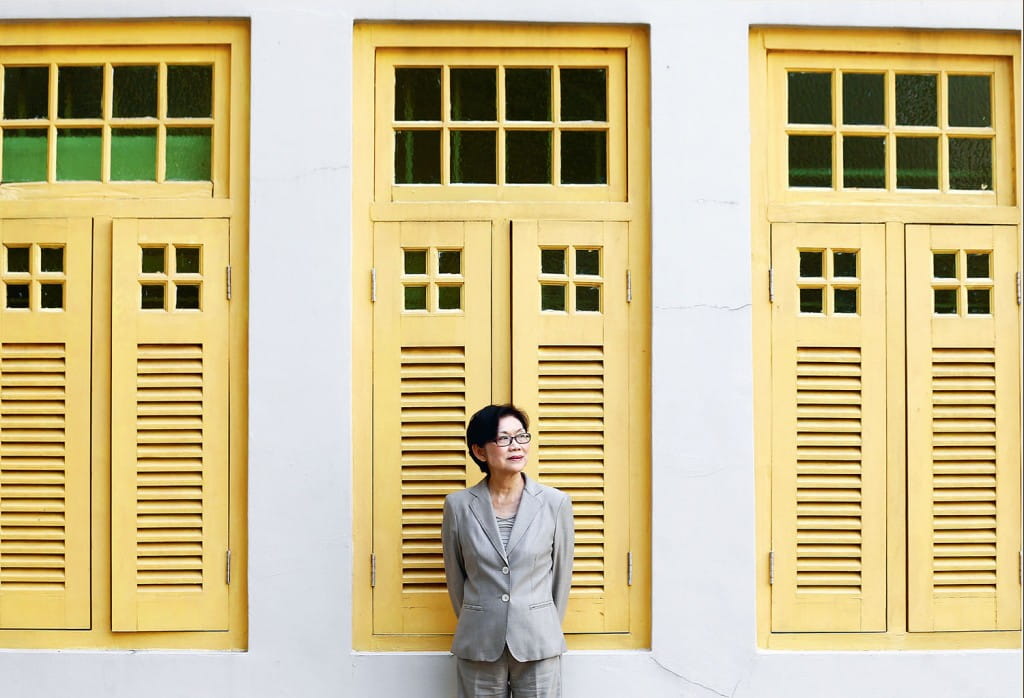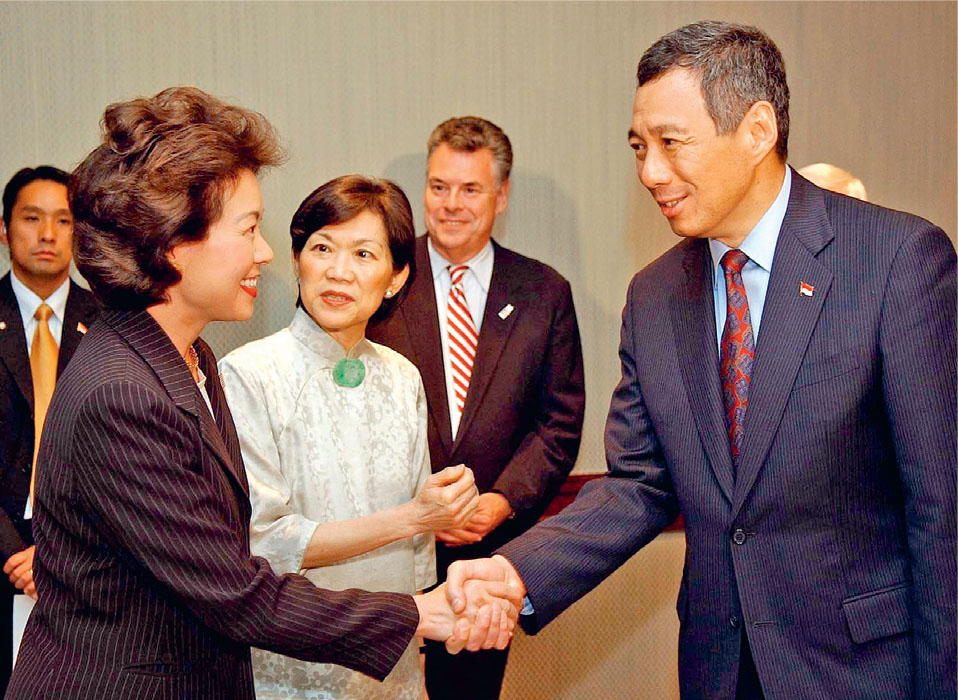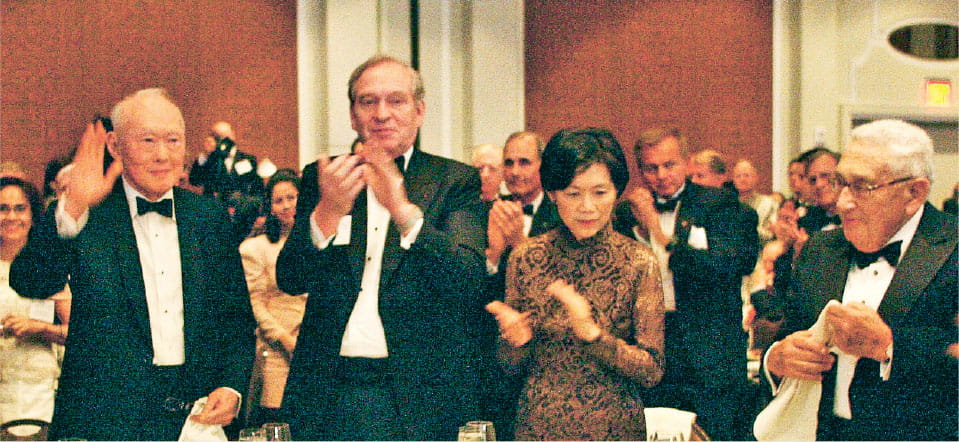
As one of Singapore’s longest-serving diplomats, Professor Chan Heng Chee epitomises what a true Singaporean should be – critical, yet gracious; strong, yet humble. We find out how she continues to contribute her knowledge and experience to the growth of several areas, including the arts and urban management.
BY LOW SHI PING
PHOTOS SPH LIBRARY
One of her career highlights was signing the US-Singapore Free Trade Agreement (FTA) in 2003 – the first FTA the US had signed with a South-east Asian country.
During her time in the US, Prof Chan introduced different aspects of Singapore’s culture to American audiences through initiatives such as organising performances or exhibitions that showcased Singaporean musicians and artists, sharing her views through talks, and serving Singaporean dishes like chilli crab to invited guests.
Since her return home, she has kept busy and shows no sign of letting up. Among the various public positions she holds is Ambassador-at-Large at the Ministry of Foreign Affairs as well as chairman of the National Arts Council (NAC), a governmentlinked organisation tasked to nurture the arts and make it an integral part of the lives of Singaporeans.
She also helms the Lee Kuan Yew Centre for Innovative Cities (LKY CIC) at the Singapore University of Technology and Design. The centre was established in 2012 to stimulate thinking and research on cities and urbanisation, and to provide innovative urban solutions.
She started her career teaching at the National University of Singapore, where she became, in 1985, the first female head of its Political Science department. She credits this experience for preparing her for her life in diplomacy, and points out that the two jobs are both about getting her audience to understand her and Singapore’s views on world affairs.
Prior to her US posting, she was Singapore’s first permanent representative to the United Nations from 1989 to 1991, and she served concurrently as high commissioner to Canada and as ambassador to Mexico.
From 1991 to 1996, she was the founding executive director of the Singapore International Foundation, a non-profit organisation that connects Singaporeans with world communities, providing opportunities for collaborations and for all to come together to promote greater international understanding and to effect positive change.
1. How have the friendships you nurtured during your diplomatic career impacted your personal and professional development?
Human relationships are extremely important. I went to Washington DC in my early 50s. When you are at that age, these friendships help shape your professional life. You never know when the relationship will become important, especially when you need to solve a problem (in future). In the diplomatic corps, we all represent countries. But if we are friends, we can try to sort things out in a more amiable fashion.
2. Citizen ambassadors help build greater understanding among countries. What key traits should a good citizen ambassador possess?
Singaporeans should be open-minded and accept other countries for what they are. Do not always measure (others) against the standards of Singapore. We are constantly told we are arrogant, so we should be aware of that.
3. How has cultural diplomacy helped to build better understanding across borders?
Cultural diplomacy helps our artists improve their skills and provides an opportunity for them to perform and learn from overseas. It also shows a facet of Singapore that might be different from the common perception. We have an economic personality and a political personality. But we have a cultural personality, too. Through our artists, the world can have a glimpse into the soul of Singapore.
4. How have you used arts and culture to connect communities?
When I first went to Washington DC, I worked with the Washington Ballet to stage a retrospective of the works of (renowned Singaporean ballet dancer and choreographer) Goh Choo San. Over the years, I have held several ticketed events under the Embassy Series, which works with ambassadors to host concerts in their embassies. I brought in Singaporean artists such as classical string quartet the T’ang Quartet, violinist Siow Lee Chin and pianist Abigail Sin.
5. How effective is the use of arts and culture to promote the country internationally?
Many countries have gone before us to take the lead in cultural diplomacy. They also spend a lot of money on the arts. When you stay at the game long enough, it leaves an impact. Every country has to balance what its needs are and how much money it wants to spend on it. Singapore is beginning to use cultural diplomacy to promote itself.
6. The Singapore Government has increased efforts in supporting the arts. What is your take on the efficacy and the sustainability of developing the arts through a government-led approach versus ground-up initiatives?
On top of government funding, there was a growth in the number of young people being educated in the arts through institutions such as the School of the Arts (Sota). We also saw Singaporeans dedicated to the arts set up schools.
On the other hand, parents are also more willing to let their children explore careers in this area. The Singapore Government has also invested in the arts rather than given money to it. You can see this through its efforts to build infrastructure such as the Esplanade and the refurbishment of the Victoria Concert Hall.
While these could have been financed through patrons of the arts, which we have but are not sufficient, it could not have been done without Government support. It will be good and more sustainable if the public starts supporting the arts as patrons and audiences.
On sustainability, if the Government steps back on funding, who is going to do it then? Certainly, contributions from the public will be welcome but the reality of arts support is that it requires substantial resources in the tens of millions. For sure, arts philanthropy is increasing but insufficient to the demands of the arts community because artists also want to do more ambitious projects.
There are also practical benefits to a government-led approach. Today, an artist can write a piece of music by night and teach by day at Sota. It is a common practice by artists in the US as well.
7. What can be done to help the local arts scene grow more organically? How can Singaporeans contribute?
The local arts scene is growing but not fast enough. On the other hand, arts education takes time. We are a bit impatient; we benchmark ourselves against Paris and New York. But it is still early days for us. We cannot force people to do what they don’t want to do. We can only put out good programmes, and hope to open eyes and ears.
8. How would you like to see Singapore develop artistically from here?
I hope to see artists improve their standards through studying, reading and exposing their art to others. I hope we can find them patronage, and that audiences will grow.
9. The LKY CIC is conducting a series of studies on Singapore’s challenges in the next 25 years. How can we use the knowledge gained?
We are thinking of the future. We are looking at present policies, and thinking of what the challenges are. Personally, I am looking at managing diversity. We are asking, in 25 years from now, will the Chinese-Malay-Indian-Others paradigm still be relevant? What are the new cleavages in society? Or are they the same? It does not mean that everything must be new. We look at other countries and understand how they manage their cities as much as they look at us. Any write-up of success or lack of success is instructive.
BELOW: Professor Chan Heng Chee introducing then-US secretary of labour Elaine L Chao to Singaporeʼs Prime Minister Lee Hsien Loong in Washington in 2005; Prof Chan at the US-Asean Business Councilʼs 25th anniversary gala dinner in 2009. At the table with her are (from left) Singaporeʼs founding prime minister Lee Kuan Yew, former US-Asean Business Council chairman George David and former US secretary of state Henry Kissinger.


10. Of the critical issues faced by cities and urbanisation, what solutions can Singapore offer?
Transport, for instance. A lot of countries have come to look at our electronic road pricing model but decided that, politically, they cannot execute it.
How to green the city is something else we can offer. When I was living in Washington DC, each time I returned home to Singapore, I would think how green and beautiful our city had become.
Lee Kuan Yew once said that Singapore is like a piece of jade – you keep carving and carving until it becomes finer and finer.
That is what it has become. Someone once said to me, the mark of development is maintenance; Singapore maintains the standards and quality. We have many things to share.
